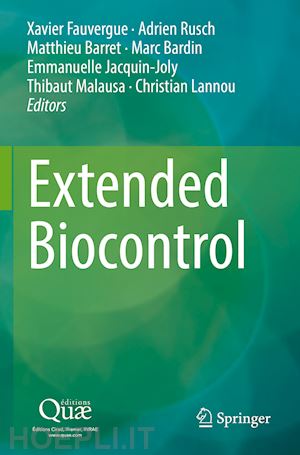Foreword
Introduction; Editor Christian Lannou
Crops Need to be Protected – But Differently
Extended Biocontrol: A Fresh Look at an Age-Old Approach
The Biocontrol Arsenal
Challenges to be Tackled
Combining Extended Biocontrol with other Plant-Health Management Methods
PART I – Biological Control: Theoretical Foundations and Applications; Editor Xavier Fauvergue
Chapter 1 Integrative Systematics and Adaptations of Natural Enemies to Their Hosts; Nicolas Ris, Éric Pierre and Jean-Claude Streito
1.1 Introduction
1.2 General Remarks on the Diversity of Macroorganisms for Biological Control
1.3 The Underlying Challenges of Identifying Beneficial Macroorganisms
1.4 A Deeper Look at Three Cross-cutting Eco-Evolutionary Themes
1.5 Conclusion
Chapter 2 The Biology of Introduced Populations; Xavier Fauvergue
2.1 Introduction
2.2 Ideas that Inspire
2.3 The Laws of Small Numbers
2.4 Lost Benefits at Small Numbers: The Allee Effect
2.5 Lower Genetic Diversity in Small Populations
2.6 Conclusion
Chapter 3 Classical Biological Control; Nicolas Borowiec and René F. H. Sforza
3.1 Introduction
3.2 Definitions, History and Evolution
3.3 Foreign Exploration
3.4 Importing Exotic Material and Performing Laboratory Evaluations
3.5 Environmental Release of Biological Control Agents
3.6 Conclusion
Chapter 4 Augmentative Biological Control Using Entomophagus Arthropods; Alexandre Bout, Nicolas Ris, Cécilia Multeau and Ludovic Mailleret
4.1 Background and Definitions
4.2 Current Challenges
4.3 Ways to Improve Augmentative Biological Control
5.4 Conclusion
Chapter 5 Sterile Insect Technique: Principles, Deployment and Prospects; Clelia Oliva, Laurence Mouton, Hervé Colinet, Alan Debelle, Patricia Gibert and Simon Fellous
5.1 Introduction
5.2 Technical Basics
5.3 Conditions of Application
5.4 Strengths and Weaknesses of SIT
5.5 Future Research Avenue
5.6 Environmental and Sociological Implications
5.7 Insects and Society
5.8 Conclusion
Part II Stimulating Natural Pest Control in Agricultural Landscapes: Theoretical and Operation Insights into Conservation Biological Control; Editor Adrien Rusch
Chapter 6 Community Ecology, Food Webs and Natural Pest Control; Lucile Muneret, Elsa Canard and Adrien Rusch
6.1 Introduction
6.2 Types of interactions within communities
6.3 Correlations between the horizontal diversity of natural enemy communities and natural pest control
6.4 The effect of vertical diversity of communities on natural pest control
6.5 Metacommunities and landscape ecology
6.6 Conclusion
Chapter 7 Agroecological management of insect pests from field to landscape; Adrien Rusch
7.1 Introduction
7.2 Principles of conservation biological control
7.3 Effects of farming practices at field level
7.4 Biological pest control at the landscape scale
7.5 Conclusion
Chapter 8 Biological control for weed management; Sandrine Petit and Stéphane Cordeau
8.1 Introduction
8.2 Weed control using sown plants
8.3 Control by seed-eating organisms
8.4 Conclusion
Part III Microorganisms and biological control; Editor Matthieu Barret
Chapter 9 Plant microbiota: diversity, transmission and function; Matthieu Barret, Marc Buée, Christophe Mougel and Corinne Vacher
Introduction
Microbial diversity according to habitats
Microbiota assembly and transmission processes
Impact of the plant microbiota on host fitness
Leveraging the microbiota to improve plant growth and health
Chapter 10 Agroecological protection to support plant health: where the microbiota fits in; Claudia Bartoli, Jean-Noël Aubertot, Isabelle Litrico and Christophe Mougel
10.1 Introduction
10.2 Agricultural production and pest management
10.3 New levers to explore: plant-microbiota interactions and their role in agricultural ecosystems
10.4 Connecting microbiota and agroecological practices
Chapter 11 Microorganisms as biocontrol products; Marc Bardin and Philippe Nicot
11.1 Introduction
11.2 Biological control: an array of microorganisms described
11.3 Commercial products
11.4 Mode of action of microbial biocontrol agents
11.5 Factors affecting the efficacy of microbial biocontrol agents
11.6 Conclusion
Chapter 12 The role of microbial metabolites in biological control; Valérie Leclère, Christophe Clément, Stéphan Dorey and Claire Prigent-Combaret
12.1 Introduction
12.2 Rhamnolipids: multi-faceted compounds
12.3 Lipopeptides: structural and activity biodiversity
12.4 Polyketides synthesized by biological control agents of the genus Pseudomonas
12.5 Conclusion
Part IV Botanical biopesticides; Editor Marc Bardin
Chapter 13 Botanical pesticides as biocontrol products; Myriam Siegwart and Anne-Violette Lavoir
13.1 Introduction
13.2 Botanical biopesticides and organic agriculture
13.3 Description of botanical biopesticides currently used as biocontrol products in France
13.4 Conclusion
Chapter 14 Challenges in developing botanical biopesticides for pest control; Anne-Violette Lavoir, Thomas Michel, Jean-Luc Poëssel and Myriam Siegwart
14.1 Introduction
14.2 Applied research process for compounds based on plant-pest interactions
14.3 Technical obstacles to overcome
14.4 Side effects to be considered
14.5 Are botanical biopesticides safe for humans?
Part V Semiochemicals and pest control: Editor Emmanuelle Jacquin-Joly
Chapter 15 Semiochemicals and communication in insects; Nicolas Montagné, Jérémy Gévar and Philippe Lucas
15.1 Introduction
15.2 Semiochemicals regulate many insect behaviours
15.2 An extraordinary diversity of semiochemicals
15.3 Methods for identifying chemical signals and analysing their perception
15.4 Conclusion
Chapter 16 Anatomy and functioning of the insect chemosensory system; Philippe Lucas, Nicolas Montagné and Emmanuelle Jacquin-Joly
16.1 Introduction
16.2 Neurophysiological organization of chemosensory systems
16.3 Neural coding of chemical signals
16.4 Chemosensory plasticity
16.5 Conclusion
Chapter 17 Semiochemicals and insect control; Sylvia Anton and Emmanuelle Jacquin-Joly
17.1 Introduction
17.2 Different uses of semiochemicals for insect control
17.3 Future prospects
17.4 Conclusion
Part VI Conditions for successful biocontrol and its large-scale deployment; Editor Thibault Malausa
Chapter 18 The challenge of biocontrol deployment; Cédric Bertrand, Thibaut Malausa and Philippe Nicot
18.1 Introduction
18.2 Field-scale biocontrol deployment: success factors
18.3 Area-wide deployment of biocontrol
18.4 Diffusing innovation across the value chain
Chapter 19 Biocontrol in France: prospects for structuring a developing sector; Manuel Boutet and Aura Parmentier Cajaiba
19.1 Introduction
19.2 Talking about biocontrol: an analysis based on scientific, media and institutional discourse
19.3 The role of biocontrol in agricultural processing
19.4 Can biocontrol be reduced to a product format?
19.5 Regulation: an unsuitable obstacle for biocontrol players, uncertainty for civil society
19.6 Biocontrol and placement on the market: moving towards pluralist business models
19.7 Conclusion
Chapter 20 Integrating biocontrol into cropping system design; Muriel Valantin-Morison, Françoise Lasserre-Joulin, Vincent Martinet, Helmut Meiss, Antoine Messéan, Jean-Marc Meynard, Foteini Paschalidou, Benjamin Perrin and Abdelhak Rouabah
20.1 Introduction
20.2 Systemic agriculture concepts and methods
20.3 The importance of the syste











